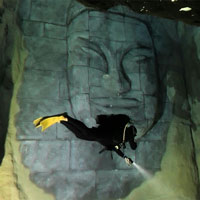You might think that acid as strong as alien blood on screen only exists in movies. However, the truth is that there is an acid that can be even more corrosive than that!
The world’s strongest super acid is called fluoroantimonic acid , chemical formula is HSbF 6 . This acid is synthesized by mixing hydrofluoric acid (HF) with antimony pentafluoride (SbF 5 ). Mixing the above mixtures in different proportions can also create super acids, but when mixed in a ratio of 1:1, the result is the strongest super acid in the world.

Two-dimensional chemical structure of fluoroantimonic acid, the strongest superacid. (Photo: Laguna Design/Getty Images).
If fluoroantimonic acid is so strong and so toxic, what is it for? The answer lies in its superacidity. Fluoroantimonic acids are used in chemical engineering and organic chemistry to develop solvent-independent organic compounds. For example, fluoroantimonic acid can be used to remove H 2 from isobutane and remove methane from neopentane. It is also used as a catalyst of alkylation and acylation in the petrochemical industry. Superacids are generally used for the synthesis and characterization of carboncations.
The reaction between hydrofluoric acid and antimony pentafluoride to form fluoroantimonic acid is an exothermic reaction.
HF + SbF 5 = H+SbF 6 –
The hydrogen ion (proton) is attached to the fluorine through a very weak dipole bond. This weak bond gives rise to the strong acidity of fluoroantimonic acid, allowing protons to move between clusters of anions.
A super acid is any acid stronger than 100% concentrated sulfuric acid. Stronger means a superacid that gives more protons or hydrogen ions in the water or has a Hammett H0 acidity lower than -12. The acidity function of fluoroantimonic acid is usually H0 = -28.
Some other superacids include carborane acid [H(CHB 11 Cl 11 )] and fluorosulfuric acid (HFSO 3 ) . Carborane acid can be considered as the strongest single superacid in the world, because fluoroantimonic acid is a mixture of hydrofluoric acid and antimony pentafluoride. Carborane acid has a pH of -18. Unlike fluoroantimonic acid and fluorosulfuric acid, carborane acid is so corrosive that it can be handled with bare hands. Teflon, the non-stick coating commonly used in kitchen utensils, may contain carborante. Carborane acid isn’t too common either, so it’s unlikely a chemistry student has ever experimented with it.
Worms have blood? If so, what color is their blood?
Top 5 most powerful stealth weapons ever built
Mysterious purple aurora confuses NASA

